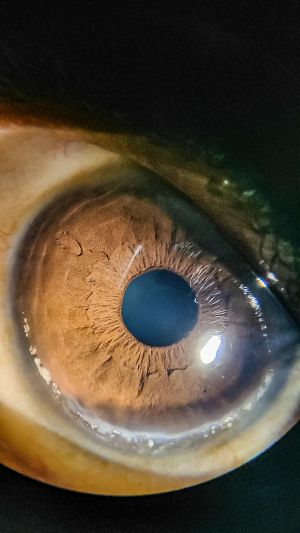Terrien's Marginal Degeneration
All content on Eyewiki is protected by copyright law and the Terms of Service. This content may not be reproduced, copied, or put into any artificial intelligence program, including large language and generative AI models, without permission from the Academy.

Terrien's marginal degeneration is a distinct marginal thinning of the cornea which causes high degree of against-the-rule astigmatism.
Disease Entity
- Peripheral degenerations of cornea, ICD-9 371.48
Disease
Terrien’s marginal degeneration is an uncommon but distinct variety of marginal thinning of the cornea. It causes a slowly progressive non-inflammatory, unilateral or asymmetrically bilateral peripheral corneal thinning and is associated with corneal neovascularization, opacification and lipid deposition. Degeneration may lead to a high degree of against-the-rule or oblique astigmatism.
Corneal thinning can be localized or involve extensive proportions of the peripheral cornea. Degeneration typically begins superiorly with mild, punctuate subepithelial and/or anterior stromal opacities and leaves a clear area between the opacities and the limbus. Opacification is followed by the development of a peripheral, superficial, fine vascular pannus, which progresses over the years to include subepithelial opacity at the advancing edge, without the overlying edge characteristic of Mooren’s ulcer. The thinning spreads circumferentially, rarely involves the inferior limbus, and leaves the epithelium intact. The central wall is steep, and the peripheral wall slopes gradually. A yellow line of lipid deposits appears at the leading edge of the pannus (central edge of the furrow). Vessels transverse the furrow and pass beyond it. Spontaneous perforation is rare, although perforation can occur easily with minor trauma. Spontaneous ruptures in Descemet’s membrane can result in interlamellar fluid or even a corneal cyst.
Etiology
Unknown.
Epidemiology
Terrien’s marginal degeneration is typically seen in patients 20-40 years of age, although it may present in childhood. It is more common in men than women (3:1). Two types have been documented. The first occurring in the older population and is asymptomatic and slowly progressive. The second more inflammatory type occurs in young to middle-aged men (75%) and occurs in the second or third decade of life. It has also been reported in patients with posterior polymorphous dystrophy, anterior basement membrane dystrophy and erythema elevatum diutinum.
General Pathology
The epithelium may be normal, thickened or thinned. Bowman’s membrane is typically absent or degenerated. Thinning and occasional breaks may be seen in Descemet’s membrane. Subepithelia fibrillar collagen degeneration has been seen with light microscopy. Electron microscopy demonstrates collagen precursors, stromal ground substance, and possibly lipid phagocytized by histiocytic cells with high lysosomal activity. Histocytes with a high degree of lysosomal activity are responsible for the destruction of collagen fibrils.
Diagnosis
The diagnosis of Terrien’s Marginal Degeneration is primarily clinical, based on history and slit lamp examination of the eye.
Physical Examination:
Physical examination reveals a leading edge of lipid, steep central edge, sloping peripheral edge, intact epithelium and superficial vascularization. Patients have a high against-the-rule or oblique astigmatism from the progressive flattening of the vertical meridian.
Signs/Symptoms:
Typically presents as painless progressive blurred vision.
Clinical Diagnosis:
Terrien’s marginal degeneration may be differentiated from other peripheral corneal thinning disorders by the lack of inflammation, presence of superficial vascularization, advancing linear deposition of lipid, lack of epithelial defect and slow progressive course. It can present with recurrent painful episodes of inflammation. Collagen vascular diseases should be excluded. No known systemic associations. Rarely, it may present as a pseudo-pterygium with a broad, flat, leading edge that arises in an oblique axis. This variant may be the same as Fuchs' superficial marginal keratitis.
Diagnostic procedures
Corneal topography reveals flattening of the peripheral thinned cornea, with steepening of the corneal surface approximately 90° away from the midpoint
Laboratory test
None
Differential diagnosis
- Collagen vascular disease
- Dellen
- Keratoconjunctivits sicca
- Fuchs' superficial marginal keratitis
- Infectious corneal ulcer
- Marginal furrow degeneration
- Mooren's ulcer
- Pellucid marginal degeneration
- Sclerokeratitis
- Staphylococcal marginal keratitis
Terrien’s is generally easy to differentiate from Mooren’s because there is no pain or inflammation, the epithelium is intact and there is no overlying edge. Inflammatory Staphylococcal lesions usually have a lucid interval between the limbus and the infiltrate and only rarely cause thinning. Marginal furrow degeneration is bilateral and avascular with only minimal, if any, thinning.
General treatment
Generally no treatment is required, unless perforation or impending perforation occurs. Initial conservative management for the severe astigmatism includes the use of spectacles or rigid gas-permeable contact lenses. Underlying corneal thinning should be monitored carefully.
Medical therapy
Most common medical therapy is contact lenses to address the corneal astigmatism.
Surgery
Surgical correction is indicated when perforation is imminent due to progressive thinning or when astigmatism significantly limits visual acuity. Crescent-shaped lamellar or full-thickness corneoscleral patch grafts may be used. These grafts have been reported to arrest progression of severe against-the-rule astigmatism for up to 20 years. Annular lamellar keratoplasty grafts may be required in severe cases of 360° marginal degeneration.
Prognosis
Most patients with do not progress to corneal perforation and can be managed successfully with glasses or contact lenses. Because there is typically no epithelial defect the risk of infectious keratitis and acute corneal thinning is low, but these patient should be monitored regularly.
Additional Resources
- Terrien’s Marginal Degeneration (Video): http://www.rootatlas.com/wordpress/video/584/terriens-marginal-degeneration-video/
References
1. External Disease and Cornea, Section 8. Basic and Clinical Science Course, American Academy of Ophthalmology, 2011-2012. 339-340.
2. Trattler, William B., Peter K. Kaiser and Neil J. Friedman. Review of Ophthalmology. New York: Elsevier Inc, 2012. 208.
3. Yanoff MD, Myron and Jay S. Duker MD. Ophthalmology. 3rd. Elsevier, 2009. 295-296.
4. Miller, Albert, Azar, Blodi et al. “Corneal Degenerations.” Albert and Jakoiec’s Principle and Practices of Ophthalmology. 3rd. Chapter 43.
5. Krachmer, Mannis and Holland. “Corneal Degenerations.” Cornea. Chapter 76.
- ↑ @2025 American Academy of Ophthalmolgy

